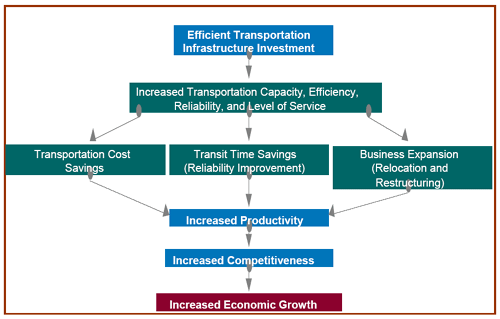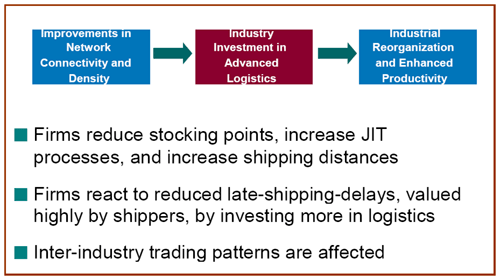1. Introduction
Transportation policy and planning is not as robust as it should be in relation to the freight sector. The Federal Highway Administration's policy and planning institutions and tools do not appropriately recognize how and why infrastructure design and capacity problems drive down the productivity of freight transportation and drive up the cost of industrial production. Likewise, FHWA cannot anticipate readily how infrastructure improvements would make freight carriers, their industrial customers, and the economy at large better off. With a significant portion of the focus of transportation policy and planning shifting to freight-related matters, filling the planning gap is essential.
Improvements in freight carriage can be expected to have important economic effects. Lower costs or better service, or both, in freight movement have a positive effect on all firms engaged in production, distribution, trade and/or retail sale of physical goods. Reducing per-mile cost of goods carriage means that any production or distribution facility can serve a wider market area, with potential gains from scale efficiencies. It also means a factory can draw supplies from a wider area with potential gains in terms of the cost and/or quality of parts and materials coming to the factory.
Beyond lower dollar costs to shippers, reductions in transit time and/or increases in schedule reliability will also have significant impacts. These gains in terms of time allow firms to manage their inventories and supply chains more efficiently. Increased reliability, for example, reduces the requirement for "buffer" stocks, inventory held to protect against delivery failure. Lower transit times reduce some costs, e.g., drivers' wages for a given trip length. Further, as with lower dollar costs, less time for a move extends the "reach" of a factory or warehouse.
In these several ways, freight improvements can spread reductions in cost and gains in productivity through all the economic sectors that produce or distribute goods (see Exhibit 1). Improvement in highway-freight carriage is one of the ways that government can make a truly valuable contribution to the efficiency of the American economy. While this may seem obvious, the impacts of freight-transportation improvements have been neglected, or been given scant attention, both in the scholarly literature on social benefits of highway improvements and in more general discussion.

Exhibit 1: Transportation and the Economy
Regardless of what scholars are writing about, managers of businesses are paying ever closer attention to efficiency in goods movement and tighter control of inventory and the whole supply chain. Logistics costs comprise transportation costs, costs of owning and operating warehouses, ordering costs, and carrying costs of inventory (principally interest and insurance). In recent years, trucking costs have been falling and reliability has been improving. Businesses have tended to respond by buying more transportation and using it to reduce the other components of logistics costs, e.g., through fewer warehouses or lower inventories. As we shall see, the tendency of managers to respond in this way to lower costs and/or improved quality of freight transportation is a fundamental source of benefits from improvements in freight carriage.
The programs of FHWA can contribute to improvements in goods movement in several ways. Clearly, highway investments that increase capacity and/or speed and reduce crashes will improve the performance of trucks. Improvements in intermodal connections will also have an effect. Intelligent Transportation System improvements can be particularly important, especially when they reduce incident-based congestion. It is clear that FHWA has a considerable capacity to bring about improvement in highway freight-carriage. It is entirely appropriate, then, that FHWA seek to measure the benefits generated by such improvements.
The most significant effort to date to study effects of highway improvement on costs and productivity of U.S. businesses is the work by Professor Ishaq Nadiri of New York University, sponsored by FHWA. Nadiri's work showed those effects to be significant. But his analysis is concerned with the impact of all highway improvements (on a fairly high-level system) on all businesses. It is not focused on freight movement as such. Freight carriage is clearly one of the effects that Nadiri captures, but not the only one, since improvements in highway passenger travel also have effects on business performance. In any event, Nadiri's work does not provide a basis for estimating benefits of future improvements in highway freight-movement. An entirely different approach is needed, one founded on the precepts of benefit-cost analysis, which is designed to estimate benefits of proposed investments.
A number of benefit-cost models have been developed for evaluation of highway investments, but none of them accords proper treatment to the benefits of freight improvements. In general, the sponsors and authors of these models have been heavily focused on user benefits for highway passengers and truck operators and have not given thorough consideration to the economics of freight movement. In the standard models, the treatment of trucks is parallel to that of passenger cars. Benefits are reckoned on the basis of reduced travel time, reduced operating costs, and reduced costs from accidents. Where cost of travel time for a car is based on value of time for the occupants, cost of travel time for a truck is based on drivers' wages. In other words, the benefit valuation is based entirely on reduction in cost to the owner of the truck—in the freight context, the benefits estimated are the benefits to the carrier. But any effects on the owner of the cargo—the shipper—are not explicit or may not be fully accounted for in this approach.
Not treating the effects of road improvement on the owners of the cargo moving over the road is a major omission. Valuing a reduction in truck travel time (referred to as "transit time" for freight) only by the saving in drivers' wages implicitly assumes there is no benefit to the shipper from getting goods to their destination more quickly. Yet it clearly must make at least some difference to the shipper if cargo is delivered earlier than it otherwise would be. This would mean, for example, that a larger number of warehouses could be reached in a day's drive from a factory, and a larger number of customers could be reached in a day's drive from a warehouse. As we have already noted, these extensions of the reach of a manufacturing or stocking facility can lead to gains from scale efficiencies and, possibly, provide opportunities for reducing total inventory.
Improvements in reliability can have effects similar to those of transit-time reductions and also allow tighter control of delivery schedules and inventories all along the supply chain. Reliability effects are usually thought to be stronger than transit-time effects alone, according to previous work done by HLB Decision Economics.[1] We can include both effects in the overall term, "time-cost reduction." When time-cost reductions are strong enough, they can lead to additional efficiency gains through the "reorganization effect." The reorganization effect occurs when a firm's managers decide that time-cost reductions, and other savings from freight improvements, are sufficient to increase length of haul and reduce the number of the firm's warehouses (see Exhibit 2). In this way, a firm takes advantage of reduced freight costs to realize scale economies in its warehouses and reduce inventory. The firm spends more on freight carriage, but the result is a reduction in total logistics costs. The objective of this study is to capture the benefits of freight improvements in the standard benefit-cost methodology. The insights discussed above provide the basis for an analytic framework that can bring the full benefits of freight improvements into the benefit-cost calculation.

Exhibit 2: How Do Firms React to Improvements in Freight Transportation?
This paper presents the conceptual framework that has been developed for this purpose. We can build on the conceptual framework to develop a method that is analytically robust, will yield useful, quantitative results, and will stand up under critical economic review. The material in this paper is presented in five sections—this introduction and four following sections:
- Section 2: Illustration of Linkages—This section explains and discusses business managers' increasing focus on reducing logistics costs while improving service to customers. Three case histories are presented that provide some insight on the ways in which businesses reorganize their logistics operations.
- Section 3: Framework for Economic Analysis—Here we present the economic concepts that will be used to estimate benefits of freight improvements and shows how those concepts provide a usable framework for the analysis. The concepts are defined and explained so as to be accessible to non-economists.
- Section 4: Estimating Quantitative Values for Benefits—In this section, we set out the approach, and related economic concepts, that will allow us to use the framework to develop quantitative values for benefits of freight improvements. The material is presented in a manner that makes it understandable for non-economists.
- Section 5: Summary and Next Steps—This section summarizes the analytical framework and the quantitative approach and identifies the next steps the study team must take to develop valid, usable estimates of benefits of freight-transportation improvements.